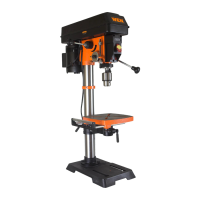SPECIFIC RULES FOR THE DRILL PRESS
12. DRILLING THE WORKPIECE.
• Allow spindle to reach full speed before drilling the workpiece.
• Never start the machine with the drill bit pressed against the workpiece.
• Adjust the table or depth stop to avoid drilling into the table.
• Set the drill press to the speed that is appropriate for the material being drilled.
13. Do not touch moving pieces. Keep hands away from the drill bit during operation. If cleaning is necessary, turn
off the machine and use a brush to remove sawdust and chips instead of your hands.
14. Never perform layout, assembly or set-up work on the table while the machine is ON.
15. After turning off the drill press, wait until the spindle comes to a complete stop before touching the workpiece.
Always turn the drill OFF before removing scrap from the table.
16. Before leaving the machine, always turn OFF and unplug the machine, remove the drill bit, and clean the table.
Turn Off and unplug the machine before cleaning, making adjustments or changing drill bits. Accidental start-ups
may occur if the tool is plugged in during an accessory change or adjustment.
17. CLEANING. Never use solvents to clean plastic parts. Solvents could dissolve or otherwise damage the material.
Use only a soft damp cloth to clean plastic parts.
18. REPLACEMENTS. Should any component of your drill press be missing/damaged or fail in any way, shut OFF
the switch and remove the plug from power supply outlet. Replace the missing, damaged, or failed parts using
only identical replacement parts before resuming operation.
CALIFORNIA PROPOSITION 65 WARNING
Some dust created by power sanding, sawing, grinding, drilling, and other construction activities may contain
chemicals, including lead, known to the State of California to cause cancer, birth defects, or other reproductive
harm. Wash hands after handling. Some examples of these chemicals are:
• Lead from lead-based paints.
• Crystalline silica from bricks, cement, and other masonry products.
• Arsenic and chromium from chemically treated lumber.
Your risk from these exposures varies depending on how often you do this type of work. To reduce your exposure
to these chemicals, work in a well-ventilated area with approved safety equipment such as dust masks specially
designed to filter out microscopic particles.
These safety instructions can’t possibly warn of every scenario that may arise with this tool,
so always make sure to stay alert and use common sense during operation.
7

